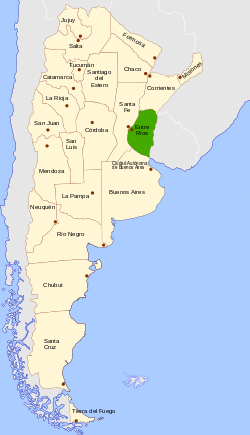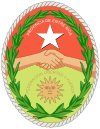Entre Ríos Province
| Entre Ríos | |||
|---|---|---|---|
| Province | |||
|
Clockwise from top: El Palmar National Park, Paraná, Carnival in Gualeguaychú, Paraná Delta with Rosario City in the background. | |||
| |||
 Location of Entre Ríos within Argentina | |||
| Country | Argentina | ||
| Departments | 17 | ||
| Municipalities and board of governors | 266 | ||
| Capital | Paraná | ||
| Government | |||
| • Governor | Gustavo Bordet (PJ) | ||
| • Deputies | 9 | ||
| • Senators | 3 | ||
| Area Ranked 17th | |||
| • Total | 78,781 km2 (30,418 sq mi) | ||
| Population (2010[1]) | |||
| • Total | 1,235,994 | ||
| • Rank | 7th | ||
| • Density | 16/km2 (41/sq mi) | ||
| Demonym(s) | entrerriano | ||
| Time zone | ART (UTC−3) | ||
| ISO 3166 code | AR-E | ||
| Website |
www | ||
Entre Ríos (Spanish pronunciation: [ˈentɾe ˈri.os], Between Rivers) is a central province of Argentina, located in the Mesopotamia region. It borders the provinces of Buenos Aires (south), Corrientes (north) and Santa Fe (west), and Uruguay in the east.
Its capital is Paraná (250,000 inhabitants), which lies on the Paraná River, opposite the city of Santa Fe.
Together with Córdoba and Santa Fe, since 1999, the province is part of the economic-political association known as the Center Region.
History

The first inhabitants of the area that is now Entre Ríos were the Charrúa and Chaná who each occupied separate parts of the region. Spaniards entered in 1520, when Rodríguez Serrano ventured up the Uruguay River searching for the Pacific Ocean.
The first permanent Spanish settlement was erected in the current La Paz Department at the end of the 16th century. As governor of Asunción first and then of Buenos Aires, Hernandarias conducted expeditions to Entre Ríos unexplored lands. Juan de Garay, after founding Santa Fe, explored this area, which he called la otra banda ("the other bank").
However, the region remained entirely indigenous and uninhabited by Europeans until a group of colonists from neighbouring Santa Fe Province settled on the Bajada del Paraná in the late seventeenth century, now the site of the provincial capital. At the same time towns appear, which we now know as Nogoyá, Victoria, Gualeguay, Gualeguaychú, Concepción del Uruguay and Concordia.
Tomás de Rocamora further explored the area in 1783 under the threat of a Portuguese invasion from Brazil, and gave official status to many of the above-mentioned towns. He was also the first to refer to the region as Entre Ríos. At this stage, European settlement was minimal, though during the May Revolution, the few colonists in the cities along the Paraná shore supported Manuel Belgrano and his army on his way to Paraguay.
On September 29, 1820, the leader (caudillo) Francisco Ramírez declared the territory an autonomous entity, the Republic of Entre Ríos. This lasted until his assassination on July 10 of the next year.
In 1853, in a meeting of all the provinces except Buenos Aires, Paraná was elected as the capital of the Argentine Confederation, and the leader (caudillo) Urquiza as its first president. The provincial capital was moved to Concepción del Uruguay. Defeated, Urquiza was elected governor of the province a few years later, while Domingo Faustino Sarmiento became president, but he was assassinated before finishing his mandate.
Urquiza encouraged immigration through "colonization contracts", setting up many agricultural colonies with European (mainly Volga Germans, Russians (including Russian Jews and Poles), Italians, Swiss and French) settlers. According to data of the 1903 census, of the 425,373 inhabitants of the province, 153,067 were immigrants.
Economy
Entre Rios' economy is the sixth largest in Argentina. Its output in 2006 was estimated at US$7.71 billion, or, US$6,710 per capita in 2006 (about a fourth less than the national average).[2] In 2013, its output was estimated at $63.814 billon Pesos (about US$11.688 billion) or, 48,327 pesos (about US$8,851) per capita at current market prices.[3][4] This was 21% below the average GDP per capita of 69,678 pesos (about US$12,762) for Argentina in 2013 at current market prices.[3][4]
Its economy has long been more agricultural than the median in Argentina, comprising about 15% of output. Entre Rios' agricultural products include rice (60% of the national production), soybeans, wheat, maize, and citrus of which it is the second biggest producer, and exporting 16% of the production mainly to Europe.
Livestock production focuses on cattle (4.5 million head), and in sheep production in a decreasing proportion, covering 60,000 km². The dairy industry, currently in expansion, produces almost 250 thousand tons per year of dairy products.
Of the national production of chickens and eggs, Entre Ríos contributes 37% of the first and 25% percent of the second. Another emerging production is honey and its derivatives, mainly for export.
Manufacturing has a sizable presence in Entre Rios, making up another 15% of output. Its industries are mostly linked to agriculture, as in food and drinks industry and flour and rice mills. Other industries include timber-wood, chemical, metallurgy, and machinery.
Geography and climate
_-_Botes_sobre_el_r%C3%ADo_Uruguay.jpg)
As part of the Mesopotamic region, the land is almost completely flat, with hills some 100 meters in height. There are two main systems of low hills, called lomadas or cuchillas: the Cuchilla de Montiel (west) and the Cuchilla Grande (east), which are separated by the Gualeguay River.
The name of the province means "between rivers". Entre Ríos is limited and traversed by many rivers and streams: the Paraná River and its delta to the west and south; the Uruguay River and the Mocoretá River to the east; and the Guayquiraró River to the north.
The weather variates form subtropical in the north to temperate towards the Pampas. The annual rainfall is about 1150 mm in average, and occasional pampero and other local winds bring storms to the area.
Two national parks are located within the province: El Palmar National Park and Predelta National Park. There are also hot springs in several locations, especially along the basin of the Uruguay River, located in cities like Federación, Villa Elisa, Colón, etc.
Political division
(Spanish: departamentos singular departamento).
The province is divided in 17 departments Department (Capital)
- Colón (Colón)
- Concordia (Concordia)
- Diamante (Diamante)
- Federación (Federación)
- Federal (Federal)
- Gualeguay (Gualeguay)
- Gualeguaychú (Gualeguaychú)
- Islas del Ibicuy (Villa Paranacito)
- La Paz (La Paz)
- Nogoyá (Nogoyá)
- Paraná (Paraná)
- San José de Feliciano (San José de Feliciano)
- San Salvador (San Salvador)
- Tala (Rosario del Tala)
- Uruguay (Concepción del Uruguay)
- Victoria (Victoria)
- Villaguay (Villaguay)
References
- ↑ "Censo 2010 Argentina resultados definitivos: mapas". 200.51.91.231. Retrieved 2013-11-29.
- ↑ "El déficit consolidado de las provincias rondará los $11.500 millones este año" (in Spanish). Instituto Argentino para el Desarrollo de las Economías Regionales. Retrieved 10 July 2015.
- 1 2 "Estimación Producto Bruto Provincial de Entre Ríos" (PDF) (in Spanish). Dirección General de Estadísticas y Censos de la Provincia de Entre Ríos. Retrieved 11 July 2015.
- 1 2 The average exchange for 1 US dollar was 5.46 Argentine pesos in 2013 according to the World Bank
External links
| Wikimedia Commons has media related to Entre Ríos. |
- Official website (Spanish)
- Universidad Nacional de Entre Ríos (Spanish)
- Pictures of Entre Ríos
Coordinates: 32°02′52″S 60°16′52″W / 32.0477°S 60.281°W


